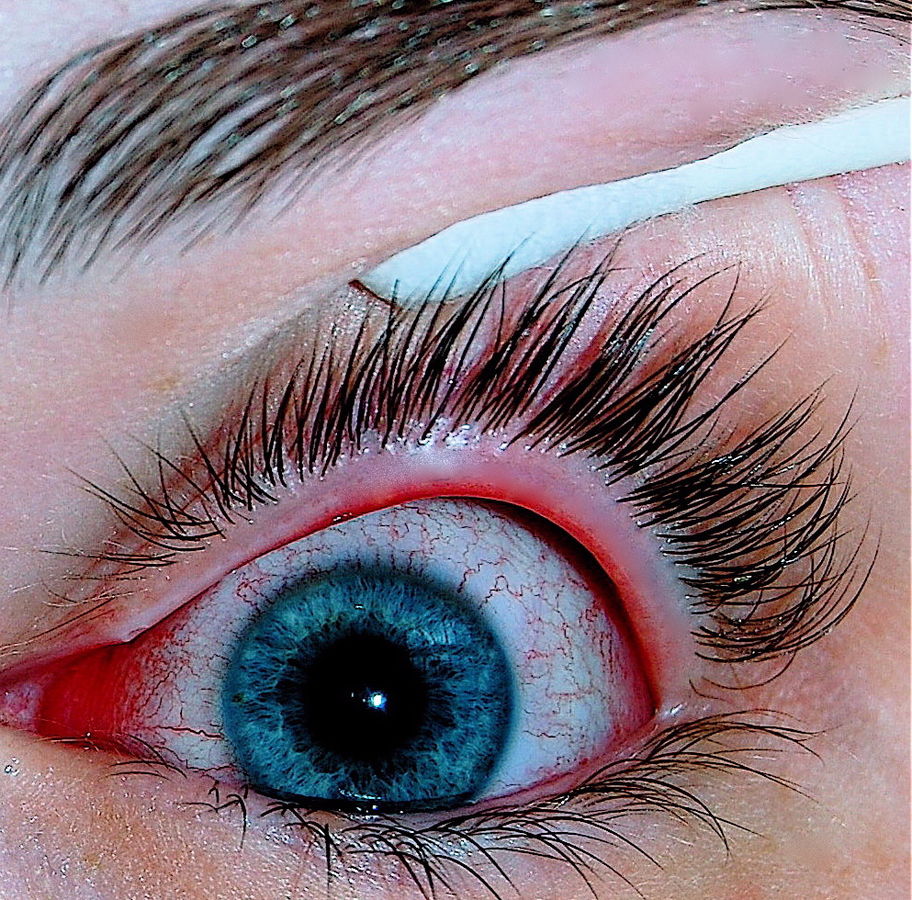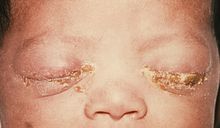Conjunctivitis pathophysiology: Difference between revisions
No edit summary |
No edit summary |
||
| Line 36: | Line 36: | ||
* Ocular allergy | * Ocular allergy | ||
* Dysfunction of the [[lacrimal gland]] with reduced tear production and mucin deficiency | * Dysfunction of the [[lacrimal gland]] with reduced tear production and mucin deficiency | ||
Keratoconjunctivitis sicca-associated [[Sjögren's syndrome]] | Keratoconjunctivitis sicca-associated [[Sjögren's syndrome]], can lead to chronic inflammatory state with production of [[autoantibodies]] such as: | ||
*[[Antinuclear antibody]] (ANA), | *[[Antinuclear antibody]] (ANA), | ||
*[[Rheumatoid factor]] (RF), | *[[Rheumatoid factor]] (RF), | ||
| Line 46: | Line 46: | ||
'''Superior limbic keratoconjunctivitis''' (SLK) is a disease characterized by [[inflammation]] of the upper palpebral and superior bulbar conjunctiva, and [[keratinization]] of the superior limbus, corneal filaments, and conjunctival [[filaments]]. | '''Superior limbic keratoconjunctivitis''' (SLK) is a disease characterized by [[inflammation]] of the upper palpebral and superior bulbar conjunctiva, and [[keratinization]] of the superior limbus, corneal filaments, and conjunctival [[filaments]]. | ||
The exact pathogenesis of superior limbic keratoconjunctivitis is not fully understood, however association between thyroid abnormalities ([[Graves ophthalmopathy]]) and Superior limbic keratoconjunctivitis has been reported.<ref name="pmid2695351">{{cite journal| author=Nelson JD| title=Superior limbic keratoconjunctivitis (SLK). | journal=Eye (Lond) | year= 1989 | volume= 3 ( Pt 2) | issue= | pages= 180-9 | pmid=2695351 | doi=10.1038/eye.1989.26 | pmc= | url=http://www.ncbi.nlm.nih.gov/entrez/eutils/elink.fcgi?dbfrom=pubmed&tool=sumsearch.org/cite&retmode=ref&cmd=prlinks&id=2695351 }} </ref><ref name="pmid25792798">{{cite journal| author=Chelala E, El Rami H, Dirani A, Fakhoury H, Fadlallah A| title=Extensive superior limbic keratoconjunctivitis in Graves' disease: case report and mini-review of the literature. | journal=Clin Ophthalmol | year= 2015 | volume= 9 | issue= | pages= 467-8 | pmid=25792798 | doi=10.2147/OPTH.S79561 | pmc=4362972 | url=http://www.ncbi.nlm.nih.gov/entrez/eutils/elink.fcgi?dbfrom=pubmed&tool=sumsearch.org/cite&retmode=ref&cmd=prlinks&id=25792798 }} </ref> | The exact pathogenesis of superior limbic keratoconjunctivitis is not fully understood, however association between thyroid abnormalities ([[Graves ophthalmopathy]]) and Superior limbic keratoconjunctivitis has been reported.<ref name="pmid2695351">{{cite journal| author=Nelson JD| title=Superior limbic keratoconjunctivitis (SLK). | journal=Eye (Lond) | year= 1989 | volume= 3 ( Pt 2) | issue= | pages= 180-9 | pmid=2695351 | doi=10.1038/eye.1989.26 | pmc= | url=http://www.ncbi.nlm.nih.gov/entrez/eutils/elink.fcgi?dbfrom=pubmed&tool=sumsearch.org/cite&retmode=ref&cmd=prlinks&id=2695351 }} </ref><ref name="pmid25792798">{{cite journal| author=Chelala E, El Rami H, Dirani A, Fakhoury H, Fadlallah A| title=Extensive superior limbic keratoconjunctivitis in Graves' disease: case report and mini-review of the literature. | journal=Clin Ophthalmol | year= 2015 | volume= 9 | issue= | pages= 467-8 | pmid=25792798 | doi=10.2147/OPTH.S79561 | pmc=4362972 | url=http://www.ncbi.nlm.nih.gov/entrez/eutils/elink.fcgi?dbfrom=pubmed&tool=sumsearch.org/cite&retmode=ref&cmd=prlinks&id=25792798 }} </ref> | ||
===Gross Pathology=== | ===Gross Pathology=== | ||
| Line 62: | Line 55: | ||
*Eyelid swelling | *Eyelid swelling | ||
*[[Conjunctival hemorrhage]] (specific for Acute conjunctival hemorrhaging) | *[[Conjunctival hemorrhage]] (specific for Acute conjunctival hemorrhaging) | ||
===Microscopic histopathological analysis=== | |||
On microscopic histopathological analysis, the following are characteristic findings of conjunctivitis:<ref name=Conjunctivitis > DermNet NZ (2015)[http://www.dermnetnz.org/pathology/conjunctivitis-path.html] Accessed on June 26, 2016 </ref> | |||
*Mild spongiotic reaction pattern (low power view of the histology) | |||
*[[Eosinophils]] (Allergic conjunctivitis) | |||
*Numerous [[neutrophils]] (Bacterial conjunctivitis) | |||
*[[Hyperplastic]] with increase numbers of [[plasma cell]] (Chronic conjunctivitis) | |||
===Images=== | ===Images=== | ||
The following are gross and microscopic images associated with [[conjunctivitis]]. | The following are gross and microscopic images associated with [[conjunctivitis]]. | ||
| Line 69: | Line 70: | ||
[[Image:220px-Gonococcal_ophthalmia_neonatorum.jpg|thumb|left|frame|Neonatal conjunctivitis<ref> Centers for Disease Control and Prevention's Public Health Image Library[https://en.wikipedia.org/wiki/Neonatal_conjunctivitis#/media/File:Gonococcal_ophthalmia_neonatorum.jpg]</ref>]] | [[Image:220px-Gonococcal_ophthalmia_neonatorum.jpg|thumb|left|frame|Neonatal conjunctivitis<ref> Centers for Disease Control and Prevention's Public Health Image Library[https://en.wikipedia.org/wiki/Neonatal_conjunctivitis#/media/File:Gonococcal_ophthalmia_neonatorum.jpg]</ref>]] | ||
[[Image:chlamydial conjunctivitis.jpg|thumb|left|200px|Chlamydial conjunctivitis (Day 5-14)<ref>http://picasaweb.google.com/mcmumbi/USMLEIIImages</ref>]] | [[Image:chlamydial conjunctivitis.jpg|thumb|left|200px|Chlamydial conjunctivitis (Day 5-14)<ref>http://picasaweb.google.com/mcmumbi/USMLEIIImages</ref>]] | ||
==References== | ==References== | ||
{{Reflist|2}} | {{Reflist|2}} | ||
[[Category: | [[Category:Infectious disease]] | ||
[[Category:Ophthalmology]] | [[Category:Ophthalmology]] | ||
[[Category:Rheumatology]] | [[Category:Rheumatology]] | ||
[[Category: | [[Category:Immunology]] | ||
[[Category:Primary care]] | [[Category:Primary care]] | ||
{{WikiDoc Help Menu}} | {{WikiDoc Help Menu}} | ||
{{WikiDoc Sources}} | {{WikiDoc Sources}} | ||
Revision as of 15:19, 27 June 2016
|
Conjunctivitis Microchapters |
|
Diagnosis |
|---|
|
Treatment |
|
Case Studies |
|
Conjunctivitis pathophysiology On the Web |
|
American Roentgen Ray Society Images of Conjunctivitis pathophysiology |
|
Risk calculators and risk factors for Conjunctivitis pathophysiology |
Editor-In-Chief: C. Michael Gibson, M.S., M.D. [6] Associate Editor(s)-in-Chief: Sara Mehrsefat, M.D. [7]
Overview
Conjunctivitis is defined as inflammation of bulbar and/or palpebral conjunctiva. Conjunctivitis has many etiologies, but the majority of cases can be caused by allergies, viruses, or bacteria. Viral conjunctivitis, typically caused by Adenovirus, is a common, self-limiting condition. Bacterial conjunctivitishas many etiologies, such as Staphylococcus, Streptococcus, Corynebacterium, Haemophilus, Pseudomonas, and Moraxella.[1] Allergic conjunctivitis may occur seasonally when pollen counts are high, and this type of conjunctivitis is a common occurrence in people who have other signs of allergic disease.[2]
Pathophysiology
Infective conjunctivitis is an infection of the conjunctiva either caused by viruses or bacteria . Both the palpebral and the bulbar ocular conjunctival surfaces are usually affected, and typically become red and inflamed. Infective conjunctivitis is spread by:[1][2]
- Direct contact with the infected person’s eye drainage or drainage from the person’s cough, sneeze, or runny nose
- Contact with the infected person’s fingers, hands or objects (eye makeup applicators, towels, shared eye medications) that may have the infected person’s drainage on them
- Adjacent infectious sites (rubbing of the eyes)
Any change in the host defense, or in the species of normal flora of the eye, such as Streptococci, Staphylococci, and Corynebacteria, can lead to clinical infection and conjunctivitis. Change in the normal flora can occurred by:[3]
- External contamination
- Contact lens wear
- Swimming
Viral conjunctivitis, typically caused by Adenovirus, is a common, self-limiting condition. Viral conjunctivitis is highly contagious, and patients should avoid direct or indirect contact with other healthy individuals. Acute hemorrhagic conjunctivitis may be caused by Picornaviruses that are clinically similar to adenovirus conjunctivitis, but are more severe and hemorrhagic. Acute hemorrhagic conjunctivitis also occurs in epidemics, and is characterized by sudden onset of painful, swollen red eyes with conjunctival hemorrhage and excessive tearing.[4]
Neonatal conjunctivitis is occurring in a newborn during the first month of life, and often known as ophthalmia neonatorum. On gross pathology, It is characterized by eyelids edema, erythema of the palpebral conjunctivae, and purulent eye discharge. On a Gram stained of conjunctival smear, one or more polymorph nuclear per oil immersion field may be detected. Additionally, neonatal conjunctivitis may caused by irritation or a blocked tear duct.[5]
Airborne antigens may be involved in the pathogenesis of allergic conjunctivitis. Common airborne antigens include pollen, grass, and weeds.[6][7]
Development of allergic conjunctivitis is the result of type I hypersensitivity reactions involving the conjunctiva. IgE and mast cells play an important role in these allergic inflammations, and there is a strong association with atopic dermatitis and allergic conjunctivitis. Combination of type I and type IV hypersensitivity reactions may be responsible for giant papillary conjunctivitis. Also, prolonged mechanical irritation to the superior tarsal conjunctiva of the upper lid from foreign bodies may also be a contributing factor in giant papillary conjunctivitis.[8][9]
Keratoconjunctivitis sicca, or dry eye syndrome, is a multifactorial disease and associated with different medical conditions such as:[10][11]
- Sjögren's syndrome
- Ocular surface disease
- Ocular allergy
- Dysfunction of the lacrimal gland with reduced tear production and mucin deficiency
Keratoconjunctivitis sicca-associated Sjögren's syndrome, can lead to chronic inflammatory state with production of autoantibodies such as:
- Antinuclear antibody (ANA),
- Rheumatoid factor (RF),
- Fodrin (a cytoskeletal protein),
- Muscarinic M3 receptor, or
- Sjögren's syndrome-specific antibodies (anti-RO and anti-LA).
Focal infiltration of the lacrimal gland and conjunctiva with CD4+ T cells and B cells can induce apoptosis, and this results in dysfunction of the lacrimal gland with reduced tear production.
Superior limbic keratoconjunctivitis (SLK) is a disease characterized by inflammation of the upper palpebral and superior bulbar conjunctiva, and keratinization of the superior limbus, corneal filaments, and conjunctival filaments. The exact pathogenesis of superior limbic keratoconjunctivitis is not fully understood, however association between thyroid abnormalities (Graves ophthalmopathy) and Superior limbic keratoconjunctivitis has been reported.[12][13]
Gross Pathology
On gross pathology, the following are characteristic findings of conjunctivitis:[14]
- Conjunctival injection
- Mucopurulent or non-purulent discharge
- Pseudomembrane formation
- Chemosis
- Eyelid swelling
- Conjunctival hemorrhage (specific for Acute conjunctival hemorrhaging)
Microscopic histopathological analysis
On microscopic histopathological analysis, the following are characteristic findings of conjunctivitis:[15]
- Mild spongiotic reaction pattern (low power view of the histology)
- Eosinophils (Allergic conjunctivitis)
- Numerous neutrophils (Bacterial conjunctivitis)
- Hyperplastic with increase numbers of plasma cell (Chronic conjunctivitis)
Images
The following are gross and microscopic images associated with conjunctivitis.




References
- ↑ 1.0 1.1 Azari AA, Barney NP (2013). "Conjunctivitis: a systematic review of diagnosis and treatment". JAMA. 310 (16): 1721–9. doi:10.1001/jama.2013.280318. PMC 4049531. PMID 24150468.
- ↑ 2.0 2.1 Kyei S, Koffuor GA, Ramkissoon P, Abokyi S, Owusu-Afriyie O, Wiredu EA (2015). "Possible Mechanism of Action of the Antiallergic Effect of an Aqueous Extract of Heliotropium indicum L. in Ovalbumin-Induced Allergic Conjunctivitis". J Allergy (Cairo). 2015: 245370. doi:10.1155/2015/245370. PMC 4657065. PMID 26681960.
- ↑ Everitt H, Kumar S, Little P (2003). "A qualitative study of patients' perceptions of acute infective conjunctivitis". Br J Gen Pract. 53 (486): 36–41. PMC 1314490. PMID 12564275.
- ↑ Centers for Disease Control and Prevention (2004) https://www.cdc.gov/mmwr/preview/mmwrhtml/mm5328a2.htm Accessed on June 24, 2016
- ↑ Mallika P, Asok T, Faisal H, Aziz S, Tan A, Intan G (2008). "Neonatal conjunctivitis - a review". Malays Fam Physician. 3 (2): 77–81. PMC 4170304. PMID 25606121.
- ↑ Malling HJ, Montagut A, Melac M, Patriarca G, Panzner P, Seberova E; et al. (2009). "Efficacy and safety of 5-grass pollen sublingual immunotherapy tablets in patients with different clinical profiles of allergic rhinoconjunctivitis". Clin Exp Allergy. 39 (3): 387–93. doi:10.1111/j.1365-2222.2008.03152.x. PMC 4233960. PMID 19134019.
- ↑ Kämpe M, Stålenheim G, Janson C, Stolt I, Carlson M (2007). "Systemic and local eosinophil inflammation during the birch pollen season in allergic patients with predominant rhinitis or asthma". Clin Mol Allergy. 5: 4. doi:10.1186/1476-7961-5-4. PMC 2174506. PMID 17967188.
- ↑ Donshik PC (1994). "Giant papillary conjunctivitis". Trans Am Ophthalmol Soc. 92: 687–744. PMC 1298525. PMID 7886881.
- ↑ Donshik PC, Porazinski AD (1999). "Giant papillary conjunctivitis in frequent-replacement contact lens wearers: a retrospective study". Trans Am Ophthalmol Soc. 97: 205–16, discussion 216-20. PMC 1298261. PMID 10703125.
- ↑ Zhang X, Zhao L, Deng S, Sun X, Wang N (2016). "Dry Eye Syndrome in Patients with Diabetes Mellitus: Prevalence, Etiology, and Clinical Characteristics". J Ophthalmol. 2016: 8201053. doi:10.1155/2016/8201053. PMC 4861815. PMID 27213053.
- ↑ Sivaraman KR, Jivrajka RV, Soin K, Bouchard CS, Movahedan A, Shorter E; et al. (2016). "Superior Limbic Keratoconjunctivitis-like Inflammation in Patients with Chronic Graft-Versus-Host Disease". Ocul Surf. doi:10.1016/j.jtos.2016.04.003. PMID 27179980.
- ↑ Nelson JD (1989). "Superior limbic keratoconjunctivitis (SLK)". Eye (Lond). 3 ( Pt 2): 180–9. doi:10.1038/eye.1989.26. PMID 2695351.
- ↑ Chelala E, El Rami H, Dirani A, Fakhoury H, Fadlallah A (2015). "Extensive superior limbic keratoconjunctivitis in Graves' disease: case report and mini-review of the literature". Clin Ophthalmol. 9: 467–8. doi:10.2147/OPTH.S79561. PMC 4362972. PMID 25792798.
- ↑ National Eye Institute (2015) [1] Accessed on June 24, 2016
- ↑ DermNet NZ (2015)[2] Accessed on June 26, 2016
- ↑ Image Courtesy of Joyhil09 [3]
- ↑ Image Courtesy of James Heilman [4]
- ↑ Centers for Disease Control and Prevention's Public Health Image Library[5]
- ↑ http://picasaweb.google.com/mcmumbi/USMLEIIImages